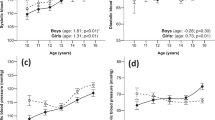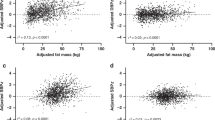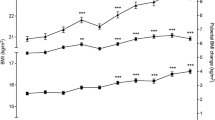Abstract
Background
Sex differences in blood pressure (BP) appear during childhood and adolescence, but the role of central precocious puberty (CPP) remains unclear. In this study, we aimed to examine the association of CPP with the risk of early hypertension and BP trajectories in girls and boys.
Methods
We analyzed trajectories of BP before and after puberty in girls aged 6–13 years (n = 305) and boys aged 10–15 years (n = 153) in the Taiwan Pubertal Longitudinal Study. The timing of puberty onset was defined as the month at which the children reached Tanner stage 2. We examined the association of CPP with the risk of early hypertension and BP trajectories before and after puberty onset.
Results
Among boys, CPP was found to be associated with early hypertension (odds ratio, 7.45 [95% CI, 1.15–48.06]), whereas no such association was observed among girls. Boys with CPP had higher systolic BP than did those with normal puberty onset before puberty onset (mean difference, 6.51 [95% CI, 0.58–12.43]) and after puberty onset (mean difference, 8.92 [95% CI, 8.58–15.26]).
Conclusion
A large proportion of the higher systolic BP observed in boys with CPP compared with in those with normal puberty onset is accrued after puberty.
Impact
-
We examined the sex-specific association of central precocious puberty with blood pressure trajectories to better understand whether central precocious puberty was associated with early hypertension.
-
Central precocious puberty was associated with differences in systolic blood pressure trajectories, especially after puberty onset in boys. For boys only, central precocious puberty was associated with early hypertension.
-
A large proportion of the higher systolic blood pressure observed in boys with central precocious puberty compared with in those with normal puberty onset was accrued after puberty. Interventions targeting central precocious puberty are likely to influence systolic blood pressure in early adulthood.
This is a preview of subscription content, access via your institution
Access options
Subscribe to this journal
Receive 14 print issues and online access
$259.00 per year
only $18.50 per issue
Buy this article
- Purchase on Springer Link
- Instant access to full article PDF
Prices may be subject to local taxes which are calculated during checkout


Similar content being viewed by others
Data availability
Data are managed by the Taiwan Pubertal Longitudinal Study (TPLS). We analyzed the restricted-use TPLS dataset that are only available by application to the TPLS Data Access Center.
References
Shen, W. et al. Race and sex differences of long-term blood pressure profiles from childhood and adult hypertension: the Bogalusa Heart Study. Hypertension 70, 66–74 (2017).
Wills, A. K. et al. Life course trajectories of systolic blood pressure using longitudinal data from eight Uk cohorts. PLoS Med. 8, e1000440 (2011).
O’Keeffe, L. M. et al. Sex-specific trajectories of measures of cardiovascular health during childhood and adolescence: a prospective cohort study. Atherosclerosis 278, 190–196 (2018).
Dasgupta, K. et al. Emergence of sex differences in prevalence of high systolic blood pressure: analysis of a longitudinal adolescent cohort. Circulation 114, 2663–2670 (2006).
O’Keeffe, L. M. et al. Data on trajectories of measures of cardiovascular health in the Avon Longitudinal Study of parents and children (Alspac). Data Brief 23, 103687 (2019).
Ji, H. et al. Sex differences in blood pressure trajectories over the life course. JAMA Cardiol. 5, 19–26 (2020).
Gerdts, E. et al. Sex differences in arterial hypertension: a scientific statement from the Esc Council on Hypertension, the European Association of Preventive Cardiology, Association of Cardiovascular Nursing and Allied Professions, the Esc Council for Cardiology Practice, and the Esc Working Group on cardiovascular pharmacotherapy. Eur. Heart J. 43, 4777–4788 (2022).
Colafella, K. M. M. & Denton, K. M. Sex-specific differences in hypertension and associated cardiovascular disease. Nat. Rev. Nephrol. 14, 185–201 (2018).
Reckelhoff, J. F. Gender differences in the regulation of blood pressure. Hypertension 37, 1199–1208 (2001).
Li, Y. et al. Association between pubertal development and elevated blood pressure in children. J. Clin. Hypertens. 23, 1498–1505 (2021).
Hulanicka, B., Lipowicz, A., Kozieł, S. & Kowalisko, A. Relationship between early puberty and the risk of hypertension/overweight at age 50: evidence for a modified Barker hypothesis among Polish youth. Econ. Hum. Biol. 5, 48–60 (2007).
Bubach, S. et al. Early menarche and blood pressure in adulthood: systematic review and meta-analysis. J. Public Health 40, 476–484 (2017).
O’Neill, K. N. et al. Puberty timing and sex-specific trajectories of systolic blood pressure: a prospective cohort study. Hypertension 79, 1755–1764 (2022).
Hardy, R., Maddock, J., Ghosh, A. K., Hughes, A. D. & Kuh, D. The relationship between pubertal timing and markers of vascular and cardiac structure and function in men and women aged 60-64 years. Sci. Rep. 9, 11037 (2019).
Hardy, R., Kuh, D., Whincup, P. H. & Wadsworth, M. E. Age at puberty and adult blood pressure and body size in a British Birth Cohort Study. J. Hypertens. 24, 59–66 (2006).
Huang, L. et al. Critical body fat percentage required for puberty onset: the Taiwan Pubertal Longitudinal Study. J. Endocrinol. Investig. 46, 1177–1185 (2023).
Tanner, J. M. Normal growth and techniques of growth assessment. Clin. Endocrinol. Metab. 15, 411–451 (1986).
Chen, M. & Eugster, E. A. Central precocious puberty: update on diagnosis and treatment. Paediatr. Drugs 17, 273–281 (2015).
Dong, Y. et al. National blood pressure reference for Chinese Han children and adolescents aged 7 to 17 years. Hypertension 70, 897–906 (2017).
Bouillet, L. Diagnostic Des Angioedèmes Héréditaires. La Presse Méd. 44, 52–56 (2015).
Demirel, M., Gürsoy, G. & Yıldız, M. Does treatment of either hypothyroidy or hyperthyroidy affect diurnal blood pressure. Arch. Iran. Med. 20, 572–580 (2017).
Koutras, D. A. Disturbances of menstruation in thyroid disease. Ann. N. Y. Acad. Sci. 816, 280–284 (1997).
Jung, G. et al. Thyroid function in girls with central precocious puberty. Ann. Pediatr. Endocrinol. Metab. 24, 124–128 (2019).
Fan, H. Y. et al. Hypertension as a novel link for shared heritability in age at menarche and cardiometabolic traits. J. Clin. Endocrinol. Metab. 108, 2389–2399 (2023).
Le-Ha, C. et al. Prenatal testosterone associates with blood pressure in young adults. Hypertension 77, 1756–1764 (2021).
Chinnathambi, V., Yallampalli, C. & Sathishkumar, K. Prenatal testosterone induces sex-specific dysfunction in endothelium-dependent relaxation pathways in adult male and female rats. Biol. Reprod. 89, 97 (2013).
Cooper, R. et al. Validity of age at menarche self-reported in adulthood. J. Epidemiol. Community Health 60, 993–997 (2006).
Walker, I. V., Smith, C. R., Davies, J. H., Inskip, H. M. & Baird, J. Methods for determining pubertal status in research studies: literature review and opinions of experts and adolescents. J. Dev. Orig. Health Dis. 11, 168–187 (2020).
Calcaterra, V. et al. Hypertension during therapy with triptorelin in a girl with precocious puberty. Indian J. Pediatr. 80, 884–885 (2013).
Acknowledgements
The authors thank the Ministry of Science and Technology of Taiwan for supporting the funding of our work and thank the WALLACE for the professional English editing.
Funding
This study was supported by a grant from the Ministry of Science and Technology (MOST 110-2628-B-038-014, MOST 111-2628-B-038-022, NSTC 112-2628-B-038-005).
Author information
Authors and Affiliations
Contributions
The original idea was conceived by H.Y.F., who also conducted all analyses, interpreted the data, and wrote the initial draft of the manuscript. W.L.T. and K.L.C. conducted interpreted the data and wrote the initial draft of the manuscript. S.Y.H. and L.H. conducted a part of analyses and interpreted the data. J.W.H., M.C.T., and C.Y. provided clinical advice on data interpretation and contributed to the revisions of the final manuscript. Y.C.C. ensured the accuracy of the analytical methods, supervised the findings, and contributed to the revisions of the final manuscript. All authors reviewed and approved the final manuscript and agreed to take responsibility for all aspects of the work.
Corresponding author
Ethics declarations
Competing interests
The authors declare no competing interests.
Informed consent
Prior to the commencement of data collection, all participants and their parents/guardians completed the necessary procedures for informed and written consent (or assent, when applicable) to ensure their participation in the study.
Additional information
Publisher’s note Springer Nature remains neutral with regard to jurisdictional claims in published maps and institutional affiliations.
Supplementary information
Rights and permissions
Springer Nature or its licensor (e.g. a society or other partner) holds exclusive rights to this article under a publishing agreement with the author(s) or other rightsholder(s); author self-archiving of the accepted manuscript version of this article is solely governed by the terms of such publishing agreement and applicable law.
About this article
Cite this article
Fan, HY., Tsai, WL., Chien, KL. et al. Associations of central precocious puberty with blood pressure trajectories: prospective cohort study. Pediatr Res 95, 1147–1152 (2024). https://doi.org/10.1038/s41390-023-02908-4
Received:
Revised:
Accepted:
Published:
Issue Date:
DOI: https://doi.org/10.1038/s41390-023-02908-4



